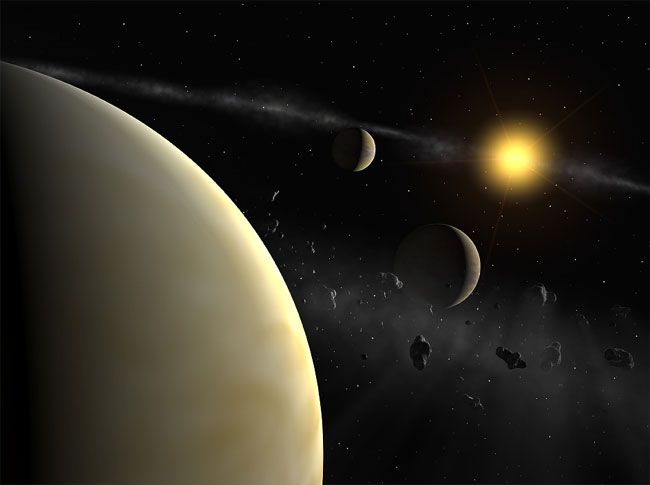Planets Found in Potentially Habitable Setup

Three medium-sized planets ofroughly the same mass as Neptune have been discovered around a nearby Sun-like star,scientists announced today.
The planets were discoveredaround HD 69830, a star slightly less massive than the Sun located 41light-years away in the constellation Puppis (theStern), using the ultra-precise HARPSspectrograph on the EuropeanSouthern Observatory's 3.6-meter La Sillatelescope in Chile.
The finding, detailed in the May18 issue of the journal Nature,marks a first for astronomers because previously discovered multi-planet solarsystems besides our own contain at least one giant, Jupiter-sized planet.
"For the first time, wehave discovered a planetary system composed of several Neptune-massplanets," said study team member Christophe Lovis of the Geneva Observatory in Switzerland.
The setupis similar to our own solar system in many ways: The outermost planets islocated just within the star's habitable zone, where temperatures are moderateenough for liquid water to form, and the system also contains an asteroid belt.
The newly discovered planetshave masses of about 10, 12 and 18 times that of Earth and they zip around thestar in rapid orbits of about 9, 32 and 197 days, respectively.
Based on their distances fromthe star, two inner worlds nearest the star are rocky planets similar toMercury, the scientists suspect. The outermost planet is thought to have asolid core of rock and ice and shrouded by a thick gas envelope.
Breaking space news, the latest updates on rocket launches, skywatching events and more!
Recent observations by NASA's SpitzerSpace Telescope last year revealed that HD 69830 also hosts an asteroidbelt, making it the only other Sun-like star known to have one.
When the asteroid belt wasfound, it was suspected that there might be an unseen planet that wasshepherding the asteroids; it now seems that there is more than one shepherd.The researchers think the asteroid belt could lie between the two outermost planetsor beyond the third planet.
The planets have not beenphotographed. They were found using the Doppler, or "wobble,"technique, in which astronomers infer the presence of a planet by measuring thegravitational influence it exerts on its parent star. This technique was usedto find most of the more than 180planets so far discovered.
In the early years of planethunting, the wobble technique was sensitive enough to spot only large, massiveplanets because they produce more significant stellar wobbles. However, thetechnique has since been refined to the point where lower-mass planets can now bedetected.
- A Star Like Our Own
- Asteroids Likely Found around Sun-like Star
- Detecting Other Worlds: The Wobble Method
- Small Rocky Planet Found Orbiting Normal Star
Ker Than is a science writer and children's book author who joined Space.com as a Staff Writer from 2005 to 2007. Ker covered astronomy and human spaceflight while at Space.com, including space shuttle launches, and has authored three science books for kids about earthquakes, stars and black holes. Ker's work has also appeared in National Geographic, Nature News, New Scientist and Sky & Telescope, among others. He earned a bachelor's degree in biology from UC Irvine and a master's degree in science journalism from New York University. Ker is currently the Director of Science Communications at Stanford University.
